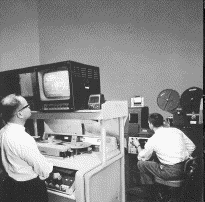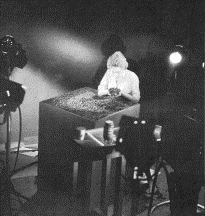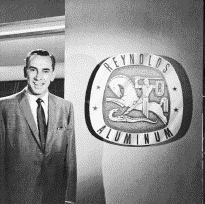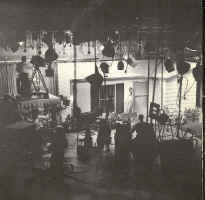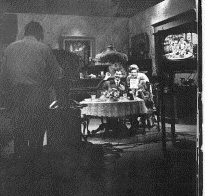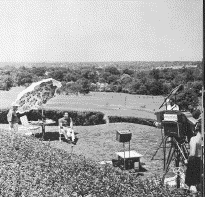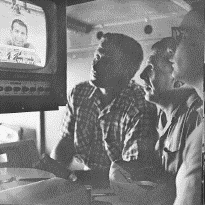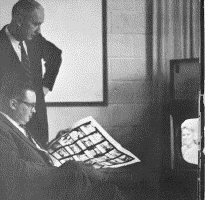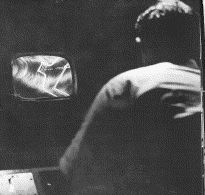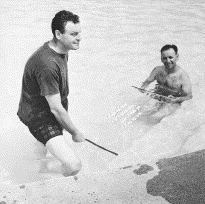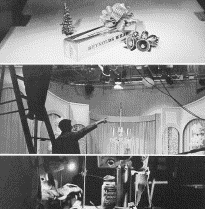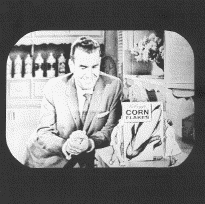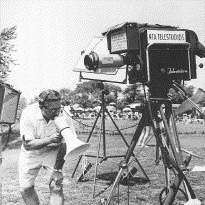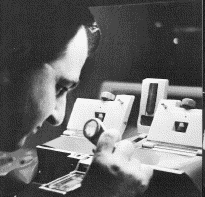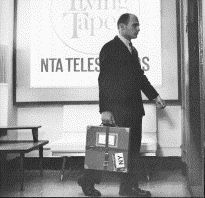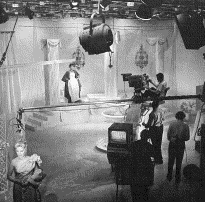|
NTA Telestudios |
|
|
A SERVICE OF NTA TELESTUDIOS LTD. / JANUARY, 1960 QUESTIONS AND ANSWERS ABOUT VIDEO TAPE COMMERCIALS TO TELL YOU: NTA TELESTUDIOS LTD. |
|
| The use of Video
Tape has doubled during the past year, and many people are coming into
contact with tape production for the first time. Because of this rapid
growth, there exist many areas of conflicting opinion and pure
misinformation.
On many occasions, we at NTA Telestudios have been called upon to set forth the facts and dispel some of the confusion. We have conducted numerous demonstrations and seminars, and out of these have grown the impetus for this factbook. After compiling the most common questions, we asked George Gould, President of the company, to answer them in a forthright, non-technical manner. We trust this book will help you to evaluate tape as a production tool for TV commercials. |
|
| GENERAL
INFORMATION
Q How many stations are equipped for Video Tape? A 163 stations were equipped with Ampex recorders at the end of 1959. Coverage included 82 markets representing 95.5% of the viewing audience. Q Can I use tape for a campaign? A Yes and no. We've produced spot campaigns on tape for up to 28 markets. Nationwide spot use is not yet possible.Q How about 16mm transfers? Are they good? How much do they cost? How does it take? A Good quality film transfers from tape are available in 16mm, and 35mm from several of the major tape producers. This quality is not equal to that of regular motion picture film. Also, because of the many variables, the quality of tape film is difficult to control. However, good quality transfers are considered by many agencies an adequate substitute for tape in markets not yet tape-covered. Film transfers range about $5.00 per 60-second print after an initial cost of approximately $100.00 for the negative transferred from tape. Delivery is about 3 days after transfer. Q Are there any technical problems in using tapes for network? ... for spot? A There are no problems in network use. None, either, in spot use except that in a taped show, at a one-machine station, the spot will be edited into the show tape. At the present state of the art, this may result in "flop over" and "skewing" immediately after the splice. In a two-machine station, the spot is run on machine #2 with no problems. There may be a "flop over", but only on the "black" preceding and following the spot. |
|
|
Q Are tape commercials available for film shows? A Definitely. Tape looks its best on a film show. Examples: Sealtest in BAT MASTERSON and Reynolds on ALLSTAR GOLF and ADVENTURES IN PARADISE. Q What are the primary advantages of tape? A "Presence" is tape's most important single advantage. "Presence" increases: *Believability *Association *Acceptance Tape is currently the highest quality means of transmitting a TV advertiser's message. Other advantages of tape: Ability to alter, adjust, substitute, delete, restage and revise while in production. Allows all creative people to view and contribute to the final production. Immediate playback, including opticals. Q Are there any union problems in using tape? A No. The problems have been resolved or are at a stage of negotiation which permits an unrestricted interchange of tapes . 3 |
|
| Q Ampex and RCA are
the sole manufacturers of tape recorders, How many of each company's
machines are in use and can tapes made on RCA machines be played back on
Ampex machines?
A 280 Ampex recorders and 23 RCA recorders were in use as of the end of 1959. RCA recorders delivered after this time were fully compatible with the Ampex machines. Q Are there many advertisers using tape today? A Yes. Though there is no accurate count in the industry, the NTA Telestudios current production list includes every major agency and such important TV advertisers as: Reynolds Aluminum, Sealtest, Kellogg's, Westclox, Marlboro, DuPont, Armstrong, Alcoa, Chase & Sanborn, Bisquick, Cheer, Scott Tissues, Newport, Dove and many others. Of course, a number of other advertisers have taped commercials at networks and other tape studios.Q Who is producing color tape? A As of January, 1960, only NBC was producing color tape in New York. Both Ampex and RCA machines are fully adaptable and convertible to color recording when needed. Incidentally, many commercials are currently produced on black and white tape for integration into color productions.5 |
|
| Q How does tape
cost compare to film? There's been a lot of conflicting talk. V
A There sure has, much of it derived from special and non-representative situations. Generally speaking, tape production costs less. Savings vary from 0 to 40 percent, depending on the number of commercials that can be taped in a day. AFTRA talent costs are somewhat higher than SAG's. Watch the next 12 months on this. Tape copies cost more than film prints. The industry is working to cut this cost. Playback charges at local stations, once substantial and varying, are almost completely eliminated. Playback charges at networks are still higher than film but are being reduced. Q What should I consider in selecting a tape producer? A All well-maintained and well-operated Ampex recorders turn out a picture of uniform excellence. There are no major or even minor engineering "secrets" or "special standards" that distinguish one tape producer from the other. Ampex has carefully engineered their equipment for performance to uniformly high standards and the fruits of its continuing developmental program on the improvement in tape quality and techniques are distributed to the entire industry.As in film, where the performance of the Mitchell and the stock in its magazines is standardized, the differential in the final tape product is determined only by the skill and talents that are applied to it. Your judgment, therefore, in choosing a tape producer should be based upon an evaluation of the performance of the people that make up the organization. A fresh and copious sample reel is your best guide here. Also, major producers will be glad to furnish you with their current "air" list. 7 |
|
|
Q Why does the tape look "live? A Those of us who grew up in radio recall the term "presence". It referred to the quality of a voice or music made up of an admixture of fundamentals, odd and even order harmonics, reverberations and other acoustical potpourri which made it sound "live, " as against "recorded".Videotape looks "live because it has visual "presence", a commodity made up of grey scale, gamma, resolution, etc. There is evidence that "believability," "acceptance" and "association" are considerably reinforced by this element. Q It has been said that tape's resolution and contrast range are less than that of film. Then why does it look so great? A This is true only when film is viewed on a projection screen. When it passes through the television system this extra resolution and contrast range is chopped off, actually wasted. It is then that the several exclusive values of video tape combine to make it look better than film on the home TV receiver. (9) |
|
| PREPARATION
Q Can everything that is done on film be done on tape? A No. Full animation cannot presently be accomplished on tape. While electronic opticals are numerous and varied, they cannot yet duplicate completely those of film. Present day tape equipment is heavy and bulky and restrictive for such location work as can be handled, for instance, by a hand-held 35mm camera. Q Is there a different approach in writing for tape? A Yes, but it is not formidable. In most cases, with adequate briefing and indoctrination, a copywriter can mold any creative idea into an effective tape commercial. Q Are you restricted to studio production? A No. Tape equipment can be moved into any suitable location, indoors or outdoors, and produce pictures with an entirely new photographic dimension. The techniques for fine location photography are not yet universally developed. Again, your best guide in choosing a tape producer are the samples of his work. Q Must you shoot in sequence? A No, you may use any shooting pattern that makes production sense. Q Can you work from a pre-recorded track? Can music and sound effects be added later? 11 |
|
| A Yes, to both
questions. In fact, most of our recent work has been done in this manner.
Q Will we be able to make copy changes in the track after the session is over? A Yes For example, in a recent Kellogg commercial, taped on location, the performer missed an important word in the final "take". The error was so slight that it wasn't caught until several days later. By using an outtake with the correct word in it, and by careful editing, the track was corrected. Q Can we have "before" and "after" scenes? scenes? A Yes, with several different methods of transition. Q What kin of wipes can you do? A Below are some of the standard wipes already engineered into most tape studios. How about "custom" wipes? A Custom wipes are readily available in any shape or form needed. Below are some examples of custom wipes which have been created for Telestudios clients such as Westclox and Chase & Sanborn.
|
|
| PRODUCTION
Q How many edits can you make in a 60 second commercial? A Theoretically, an unlimited number. Practically and esthetically, six to eight. Q Can you lift out 20 second and 10 second versions ? A Yes, if properly planned. Q What about reverse motion? A Can do. Q motion? A Not yet. Q How do you handle animation? A You can handle animation· as you would in a live television production ..; by rolling it in on film. In a commercial we made for Breck, we used animated film "supered" over a live model, a technique which created the impression of drops of Breck Shampoo working themselves into a lather in the hair of a live model. Effective, limited animation is possible through the use of the electronic matting technique. Q Can you wipe on titles? A Yes, either mechanically or electronically.
|
|
| Q Can you animate
titles?
A Yes. There are many ways including: Cellomatic, animatic, Mobilux, etc. Q Can you use film clips for inserts? A Absolutely -- 35mm preferably, because of quality. Q How in advance must I work in tape? A A conference held two weeks before taping, in which all production elements can be finalized, is the ideal. On a practical basis, a well-organized tape producer can service a production on a day's notice. (Please - for emergency use only) .Q How much of the production do I have to organize? A A custom commercial producer is equipped organizationally to handle all production needs, including director and talent. You need furnish the copy, supervision and any of the other production elements you choose. |
|
| Q Is there a
playback of each take as it is made?
A Yes, if desired. Q Can it be seen outside of the control room? A It is fed to a client's viewing room and the studio floor. Q Can we make changes between takes? A Of course. Q Will we be able to achieve kind of lighting our client is used to getting in film?A The "traditional flat quality of TV lighting" is a dead, but not quite extinct legend that arose from some early network TV shows. In tape, the most exquisite lighting is possible in the hands of a talented and artistic lighting director. Because your tape is seen on a TV monitor, it is possible for all concerned to see the settings, product shots, coiffures, etc., as they actually will appear on the home receiver. Q Can you handle the product shots that are traditionally difficult? i.e., : ice cream, watches, hair, skin lotions, reflective materials, etc. A Yes, with an increased visual fidelity that was never before attainable.
21 |
|
| Q How do you do
matt shots?
A A picture from camera "A" is used to cut a hole in the picture from camera "B" that is the exact shape of the "A" picture. Then this picture is inserted into "B" to form a perfect composite of the two. The cutting and inserting, of course, are done electronically. Our client likes to have his logo matted in. Can you do it? A Yes. We can fade, wipe or cut into any picture. Will we have the opportunity to try some special wipes during production? A Yes. Different wipes are selected merely by pressing a button. Q Can we bring the client in to watch? A Yes. More and more agency people are discovering the advantages in having client approval before they leave the studio. Q Is the technical vocabulary the same as in film? What terms should we use? A The actual camera vocabulary is similar. However, here are several definitions which have recently been adopted by the NAB as standard for videotape. 23 |
|
| Original: | The first videotape recording of a TV signal. |
| Master: | The first tape complete in all
its production elements.
Note: An "original" recording can also be a "master" if it is complete in all its elements, such as a production recorded in continuity. Note: The term "protection master" may be used to identify a master which has been designated for protection purposes.
|
| Copy: | Any recording made solely from a
videotape signal, whether original, master, or copy.
Note: A "copying master" is a master tape designated for use in making copies.
|
| Leader: | That portion of a videotape immediately preceding the program or commercial content. |
| Run-Out: | That portion of a videotape immediately following this program or commercial content. |
|
Q On location, are all features available, such as wipes, playback, etc.? A Yes. In addition, because of the ability to adjust electronically for changing light conditions, the shooting day is extended substantially. 25 |
|
| POST·
PRODUCTION
Q Must the tapes be played back on the same head that recorded them? A No. This is another carry-over legend from the early days of prototype recorders. We make tapes every day that are played on all 3 networks, as well as local stations all over the country. Q How many copies can you make? A About 60 to 80 from each master. Q How many masters do you make? A Usually two. Q How long does the editing take? How much does it cost? A Time is a function of the complexity of the editing job. An actual tape splice takes about 5 minutes. Editing charges run about $50 per editing hour for man and equipment. Bear in mind that your prime editing is done in the control room by camera cutting between three or four cameras. Q How many times can you play a single tape? A From 40 to 80, depending upon handling. Q Can you do A & B roll mixing in videotape? A Ampex "Intersync" has been developed specifically for this purpose and will be available by the spring of 196O. This device, incorporated into existing recorders, will permit the mixing of any number and combinations of tapes. 27 |
|
| Q Is shipping a
problem? Is it costly?
A No. Approximately $3.50 for 5 lbs. via Air Express, New York to Chicago. Two or three commercials on a metal reel will weigh less than 5 lbs. Lighter plastic reels will be available early in 1960. Q Can you erase the tape and re-use it? Does it have any refund ?A Videotape can be erased (degaussed) and re-used, similar to audio tape. It is too early to determine the refund value of commercial videotapes. An NAB committee is investigating this. Q Does tape deteriorate through age? A There is no measurable evidence that age deterioration takes place. Q Who stores the tapes? A Some tape producers offer storage service. A number of film storage services are also storing tapes. Q Why do some tapes look bad on air? A Because of poor playback; the same as in film. Is this what causes SKEWING, SCALLOPING, BANDING, DROPOUT? A Most often it is. SKEWING is the name given to the effect you see when a tape picture is made up of many horizontal bands displaced with reference to each other. All vertical lines are evenly zig-zagged. If the tape is standard, the defect is caused by improper playback. 29 |
|
|
SCALLOPING is the condition existing when vertical lines in a picture are made up of many regular curved segments -like scalloped shelving. This is relatively rare but can be compensated for before the tape is played.DROPOUTS are the small flashes that occasionally are seen running through a picture, particularly in dark scenes. They actually are minute imperfections in the tape. Minnesota Mining and Manufacturing Company is working constantly to eliminate this defect and as of the beginning of 1960 they were turning out tape with a very low dropout figure. QUADRATURE error produces irregular vertical lines in a tape picture., This is a function of less -than-perfect video head alignment and may be introduced in recording or play back. The defect is diminishing as Ampex's video head manufacturing techniques improve. We can look forward to the complete elimination of this defect within the next 12 months. Quadrature Skewing Scalloping(click for good picture of defects)
31
|
|
| Q What is being done
to standardize all the fast growing tape field ?
A The latter part of 1959 saw the major tape producers working with Ampex, RCA, NAB, and SMPTE towards the development of formal and comprehensive industry-wide standards for Videotape. While some small differences in technical standards still exist, the range of adjustment built into tape equipment iswide enough to achieve perfect interchangeability (playback from machine to machine). Improper playback of a good tape, at this stage, can only be attributed to bad technique or poorly maintained equipment. Ampex promises perfect "interspliceability" (editing together of different tapes) by mid-1960.
|
|
|
MORE
INFO! Feel Free to Email us any additional material! - info@smecc.org 9/3/2005 8:09:17 PM US Mountain Standard Time NTA
was funded by and became part of MGM. George Gould ran it and later
founded Teletronics in NYC where the first scene-by-scene computer
controlled color correction was done. The Teletronics moniker was “The
Pallette” I think the equipment was a PDP-8 driving a remoted chromacomp
in an RCA TK-27 telecine camera. The engineer at Teletronics was Armand
Serabia who patented (as sole inventor) the Teletronics color correction
system which put the original Fortel (Virgil Lowe) and a few others out of
business. We called that madness “color wars” around here. This
situation was extensively covered in the press. 9/3/2005 9:(something) PM US Mountain Standard Time Oh
my this is great info! Is there a source we can obtain that goes
into this in even greater depth? Added: 9/3/2005 9:18:54 PM US Mountain Standard Time There
were plenty of vtr’s (all vacuum tubes) in NYC around 1960. All three
networks had them as did WNEW, WOR and WPIX. The seventh VHF, PBS station
WNET didn’t go on air until 1962 and it’s predecessor, WATV, didn’t
survive long enough to have tape or color. The stations/nets used video
tape for time zone delay and pre-recorded playback but not heavy duty
production. Outside
of the stations, there were a number of independent production facilities,
mostly catering to the ad agencies, which pioneered video tape production
and who were largely responsible for the rapid maturity in video tape
equipment that made these machines into efficient editing tools. It was a
short walk from most of the agencies on The
color correction patents should be easily found by doing a USPTO search. I
believe the Teletronics system was described in a SMPTE journal. In fact,
the entire history of professional (and a few consumer) video recording
was documented in great technical detail in the SMPTE journal – it
should be the first touch point for a researcher. - John Turner
|
|

